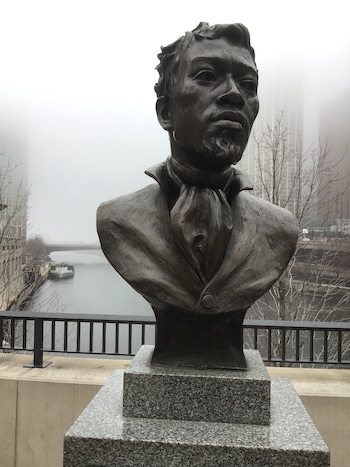T
oday was an overcast day – a little rain, a lot of fog. The bridge looked slippery. I felt a strange sensation that the river was waiting in anticipation for me to fall in. The monument stood out in the fog on the bridge over the steamy river.
The moody, gray scene grabbed me. The sculpted head’s tussled hair and bearded chin’s upward thrust resembled something… I could not make it out. For a moment he came alive. Was this a human in the flesh? No. He was a force of nature, a tornado turning and twisting out of the river onto the bridge.
That is what I saw. It is what I felt. Initially, I studied the bust for a moment and continued walking. Then I stopped, turned around and walked back to take the photograph to capture the mood.
I believe I did.
So often, it seems, our history is hiding from us, preventing the possibility that we dare look back and tell the truth – afraid of what doing so may require of us now.
– Wesley Lowery
Jean Baptiste Point Du Sable
Explorer, trader, pioneer – Jean Baptiste Point DuSable laid out the plan for Chicago. He was born in 1745 in Saint Marc, Sainte-Domingue (now Haiti). DuSable founded the settlement that later became the city of Chicago.
This remarkable man is often referred to as the “Father of Chicago.”
Millions of people live and work in the city. Each year in this world class city, more millions visit. They walk past this monument on the Michigan Avenue Bridge over the Chicago River and never really study it. Most are not aware that DuSable established a trading post near this spot, thus establishing Chicago.
The area was already settled and farmed by Potawatomi, Odawa, and Ojibwi indian tribes.
Before DuSable, other explorers did not see this spot as suitable for establishing a post or settlement. He is recognized as the first permanent non-indigenous settler at that spot.
When I stop by the statue, I experience the feelings I had as a young girl in elementary school. Who was this man? I knew only his name – Jean Baptiste Point Du Sable. What did he look like?
Some things stay the same
It did not seem possible that a free black man from Haiti arrived in the area in 1779, settled and established a home and thriving business.
He traded here, and overcame the harsh physical, psychological and political realities of the time. In spite of the racial climate, DuSable was widely respected for his skill as a fur trader, farmer, merchant and businessman.
His success sprang from his “neutral” stance and dealings with indigenous people, Americans and the British before, during and after the American Revolutionary War. He married Kitihami, a woman from the Potawatomi tribe, who was also his business partner.
The man faced daunting natural and environmental challenges. Great Lake winters exist to test and conquer anyone audacious enough to accept. In DuSable’s case, human and political forces presented his greatest problems.
For a few years, DuSable was jailed by the British for suspected American leanings. His wife was instrumental in gaining his release using familial and political connections.
Together, husband and wife continued to profit from their business. It was not easy as DuSable’s claim to his property was challenged by the federal government. Coercive treaties were being presented to native tribes to take over their lands. Eventually, the family sold the homestead complete with mansion, left Chicago, and eventually retired to Saint Charles, Missouri. DuSable died there in 1818.
In Plain Sight
It took almost two hundred years to acknowledge DuSable’s great handprint on the city of Chicago. His historical significance had been all but erased. Ironically, but not surprisingly, the man who bought DuSable’s mansion and homestead is recognized as a city founder and leader.
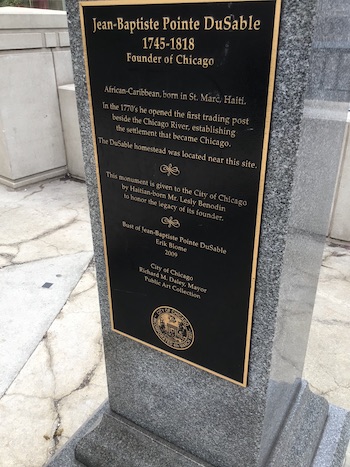
The monument stands at the north end of the Michigan Avenue bridge over the Chicago River.
You cannot miss it.
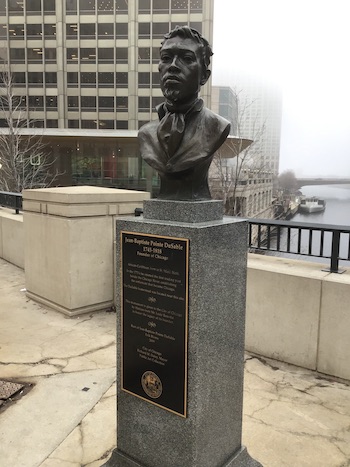
When I am in town, I make sure to stop by the monument. It is only a few blocks from the site where DuSable’s trading post existed on the Chicago River.
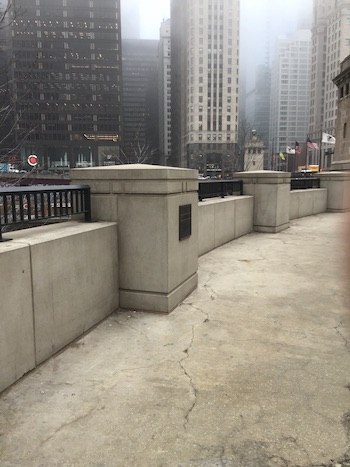
Another view of the Michigan Avenue bridge and a foggy view of nearby downtown Chicago skyscrapers.
A long view
Over the last six decades, perseverance and dedication of people – mostly individual black supporters and groups – resulted in long overdue and proper recognition of DuSable’s life and work.
This National Historic Landmark plaque designated the Jean Baptiste Point DuSable homesite as a national monument in 1977.
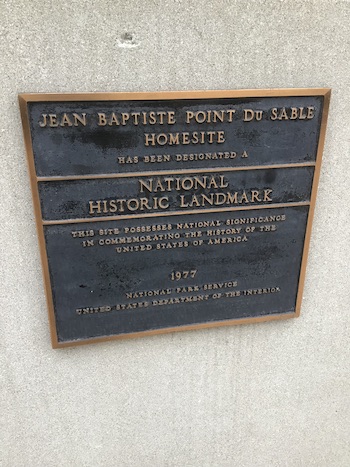
Michigan Avenue Bridge was renamed DuSable Bridge in October 2010.
Lake Shore Drive was renamed Jean-Baptiste Pointe DuSable Lake Shore Drive in 2021.
The DuSable Harbor is located within Grant Park in downtown Chicago.
Now, there are sites around the city that honor Jean Baptiste Point DuSable including:
DuSable High School and,
DuSable Museum of African American History and Education Center, (a Smithsonian Affiliate).
Both institutions are located on the city’s predominately black south side.
In 1987, the USPS issued a 22-cent stamp honoring DuSable on the 150th birthday of the city.
•
Let our greatest efforts be made to educate our children, instead of accumulating treasures for them to squander, after we have passed away.
– Simper Fidelis (Jennie Carter), 1868
Baadaye
Shirley J ♥️

